The Victor-Victrola Page
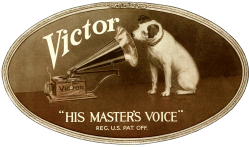
Design Details:
1. Horns
4. Soundboxes
Pictures and details on some of the design features of External Horn Victor phonographs. Each sequential page covers one aspect of the evolving designs. Advance to the next page via the link above or at the bottom of each page
BEFORE WE GET STARTED: Readers should be aware that the earliest Victor Talking Machines utilized a "Consolidated Talking Machine" or an "Eldridge Johnson" ID tag. Mr. Johnson was the founder of The Victor Talking Machine Company, and used the Consolidated name for a short period before Victor was formally incorporated in 1901. Subsequent tags used the name "Victor" but will not show the "dog and phonograph" logo. The famous dog logo appeared toward the end of 1901. Several variations on the tag designs may be found.
By the end of 1901, all Victor products used both the Victor name and famous logo as an official product identification.
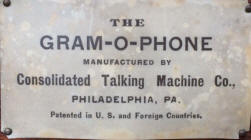
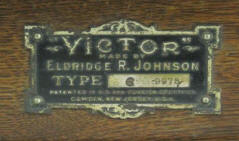
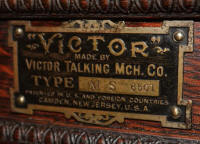
Victor Horns Note: the vast majority of horns that Victor produced were of one of these styles. However, a number of aftermarket companies could provide the Victor owner with any number of different colors or designs, including sterling silver, multi-colored, painted with flowers or other decorations, etc. These may have been originally sold as an "upgrade" by a Victor dealer, or may have been purchased at a later date. NOTE: If your horn has a different design or coloring/paintings from those shown below, and is lacking the Victor "Nipper" decal, it is likely an aftermarket product. Non-Victor (aftermarket) horns are not covered on this website.
Small
Stamped Steel Flower Horns. Victor's 'budget' model phonographs,
such as the Victor Junior and Victor 0
models, used a small painted steel horn. These horns typically measured about
14" in diameter and were stamped to shape in sections by presses and then
assembled via crimping the panels together. The "Nipper" logo appeared on a
small decal located on the horn body.
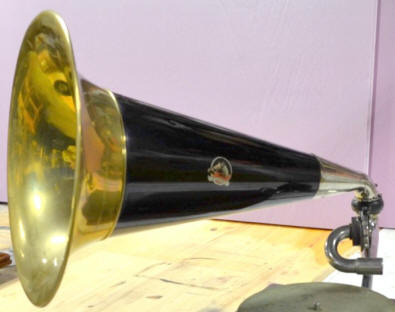 Brass Horns.
Most Victor models came with a standard brass horn, which was sized to match the
phonograph (the costlier the model, the larger the horn and the greater the
sound volume). These horns typically had a crimped steel body (painted in black)
with a stamped single-piece brass bell. A buyer could purchase (at extra cost) a
larger brass horn for any machine from the dealer. Sizes for horns ranged from a
10" diameter (for lower-priced machines) up to a whopping 46" diameter, which
required the use of an external stand for support. The "Nipper" logo appeared on
a small decal located on the horn body. These horns used brass of relatively
thin gauge, and were easily dented or damaged.
Brass Horns.
Most Victor models came with a standard brass horn, which was sized to match the
phonograph (the costlier the model, the larger the horn and the greater the
sound volume). These horns typically had a crimped steel body (painted in black)
with a stamped single-piece brass bell. A buyer could purchase (at extra cost) a
larger brass horn for any machine from the dealer. Sizes for horns ranged from a
10" diameter (for lower-priced machines) up to a whopping 46" diameter, which
required the use of an external stand for support. The "Nipper" logo appeared on
a small decal located on the horn body. These horns used brass of relatively
thin gauge, and were easily dented or damaged.
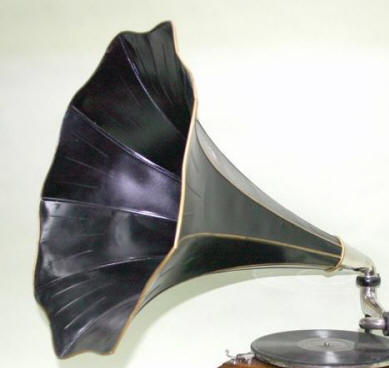 Large
Stamped-Steel Flower Horns.
As
an inexpensive option, a stamped-steel "flower" design horn could also be purchased to upgrade a
phonograph. Dealers usually carried these upgrades in stock, such that any basic
Victor phonograph could be enhanced with the more elegant flower design. These
were painted black, and the "Nipper" logo appeared on a small decal located on the horn body. Large flower
horns were not standard on any model. Dealers usually carried these upgrades in stock, such that any basic
Victor phonograph could be enhanced with the more elegant flower design. Sizes
ranged from 15" to 24" diameter.
Depending on model, these horns would add about $3.00 to $15.00 to the cost of the
phonograph.
Flower horns also came in brass
as an option for the expensive Victor VI
model.
Large
Stamped-Steel Flower Horns.
As
an inexpensive option, a stamped-steel "flower" design horn could also be purchased to upgrade a
phonograph. Dealers usually carried these upgrades in stock, such that any basic
Victor phonograph could be enhanced with the more elegant flower design. These
were painted black, and the "Nipper" logo appeared on a small decal located on the horn body. Large flower
horns were not standard on any model. Dealers usually carried these upgrades in stock, such that any basic
Victor phonograph could be enhanced with the more elegant flower design. Sizes
ranged from 15" to 24" diameter.
Depending on model, these horns would add about $3.00 to $15.00 to the cost of the
phonograph.
Flower horns also came in brass
as an option for the expensive Victor VI
model.
Smooth Wood Horns.
The most deluxe Victor horns were made of wood. Victor wood horns came in two
basic styles, and a variety of sizes. Finishes of oak or mahogany were
available. The smooth-style wood horn was a limited option for a few years and
was of a simple design, like the oak example shown on the left. Depending on model,
smooth wood horns could
add up to $10.00 to the cost of the phonograph.
The "Nipper" logo appeared
on a small decal located on the horn body (not shown in picture). These were
made by shaping and pressure-steaming layers of thin wood veneer.
Spearpoint Wood Horns.
Victor's best wood horn was the "Spearpoint", named after the pointed wood
insets. Finishes of oak or mahogany were available. Spearpoint horns are
considered highly collectible, and were an expensive option when new. The two
available sizes were 18.5" and 22" in diameter, and could add up to $15.00 to the
cost of the phonograph. The
"Nipper" logo appeared on a small decal located on the horn body (not shown in
picture).
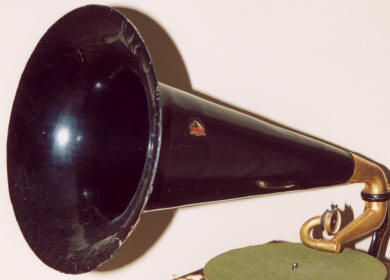 Other
Victor Horns.
There were a few unusual horns available with very early Victor phonographs,
made of materials such as paper mache', rubber, fiber and others. These were
available in 18" and 23" inch diameters, and added up to $8.00 to the cost
of the phonograph. The
"Nipper" logo appeared on a small decal located on the horn body. These
horns are rare and considered highly collectible today.
Other
Victor Horns.
There were a few unusual horns available with very early Victor phonographs,
made of materials such as paper mache', rubber, fiber and others. These were
available in 18" and 23" inch diameters, and added up to $8.00 to the cost
of the phonograph. The
"Nipper" logo appeared on a small decal located on the horn body. These
horns are rare and considered highly collectible today.
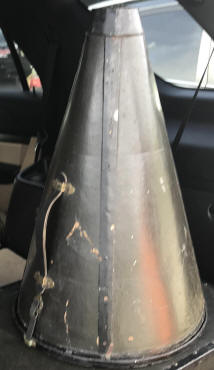 Horn
Carrying Cases. Victor also sold carrying cases for horns, to
protect them from bumps and damage while in transit. Since horns were very
fragile items, a case (for protection during a picnic trip or other journey)
was considered an important accessory. These were available in different
sizes, and sold for $2.50 and up.
Horn
Carrying Cases. Victor also sold carrying cases for horns, to
protect them from bumps and damage while in transit. Since horns were very
fragile items, a case (for protection during a picnic trip or other journey)
was considered an important accessory. These were available in different
sizes, and sold for $2.50 and up.
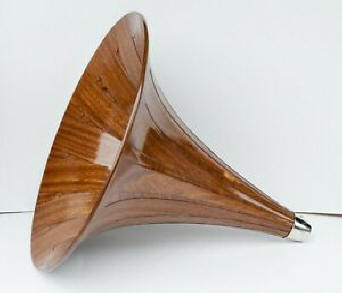 Reproduction
Horns. A number of skilled craftsman have created 'spitting image'
reproduction wood horns for Victor machines, and these can be very difficult
to discern from originals. While these horns have an outstanding appearance,
be aware that a reproduction horn on a phonograph will typically reduce its
value to serious collectors.
Reproduction
Horns. A number of skilled craftsman have created 'spitting image'
reproduction wood horns for Victor machines, and these can be very difficult
to discern from originals. While these horns have an outstanding appearance,
be aware that a reproduction horn on a phonograph will typically reduce its
value to serious collectors.


